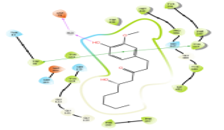Abstract
Alzheimer's disease (AD) is the most common form of dementia and one of the leading causes of death. The Aim and objective of the present study is to perform in-silico docking analysis of the major active constituents identified in three Indian medicinal plants namely Convolvulus pluricaulis, Coriandrum sativum and Panax ginseng for its effectiveness against the targets of Alzheimer Disease. In-silico docking analysis was performed by Molegro Virtual Docker (MVD-2010, 4.2.0) and Schrodinger Mestro (V 11.8). In addition, Drug likeness property, pharmacokinetics (ADME) and safety profile prediction studies were performed to identify the best drug candidates using Qikpro and Toxicity Estimation Software Tool (T.E.S.T). The target for Alzheimer Disease is Acetylcholinesterase and Butyrylcholinesterase. The X-ray crystal co-ordinates of AChE (PDB ID: 4bdt) and BChE (PDB ID: 6eqq) obtained from the Protein Data Bank. The phytoconstituents of three medicinal plants were retrieved from PubChem compound database in mol format. The standard drugs Donepezil, Rivastigmine, Galantamine, Memantine was obtained from the drug bank in. mol format for comparison. It was analysed from the parameters of docking that the phytoconstituents from Panax ginseng showed better anti-Alzheimer activity compared to that of the standard drugs. Based on the research findings, further studies can be performed in in-vitro & in-vivo animal models of Alzheimer’s disease to establish the efficacy of promising phytoconstituents.
Full text article
References
Ali, B., Jamal, Q.M., Shams, S., Al-Wabel, N.A., Siddiqui, M.U., Alzohairy, M.A., Karaawi, M.A.A., Kesari, K.K., Mushtaq, G., Kamal, M.A. 2016. In Silico Analysis of Green Tea Polyphenols as Inhibitors of AChE and BChE Enzymes in Alzheimer’s Disease Treatment. CNS & Neurological Disorders -Drug Targets, 15(5):624–628.
Becker, J.T. 1994. The Natural History of Alzheimer’s Disease. Archives of Neurology, 51(6):585–585.
Bernstein, F.C., Koetzle, T.F., Williams, G.J., Meyer, E.F., Brice, M.D., Rodgers, J.R., Kennard, O., Shimanouchi, T., Tasumi, M. 1978. The protein data bank: A computer-based archival file for macromolecular structures. Archives of Biochemistry and Biophysics, 185(2):584–591.
Bolton, E.E., Wang, Y., Thiessen, P.A., Bryant, S.H. 2008. PubChem: Integrated Platform of Small Molecules and Biological Activities. Annual Reports in Computational Chemistry, pages 217– 241.
Caputo, C.B., Salama, A.I. 1989. The amyloid proteins of Alzheimer’s disease as potential targets for drug therapy. Neurobiology of Aging, 10(5):451– 461.
Chiti, F., Dobson, C.M. 2006. Protein Misfolding, Functional Amyloid, and Human Disease. Annual Review of Biochemistry, 75(1):333–366.
Dorland, W.A.N. 1995. Dorland’s illustrated medical dictionary. 28th ed. Philadelphia: W.B saunders, 1995 ISBN: 9780721628592.
Geldmacher, D.S. 2004. Differential diagnosis of dementia syndromes. Clinics in Geriatric Medicine, 20(1):27–43.
Grant, W.B., Campbell, A., Itzhaki, R.F., Savory, J. 2002. The significance of environmental factors in the etiology of Alzheimer’s disease. Journal of Alzheimer’s Disease, 4(3):179–189.
Guedes, I.A., de Magalhães, C.S., Dardenne, L.E. 2014. Receptor–ligand molecular docking. Bio physical Reviews, 6(1):75–87.
Huppert, F.A., Tym, E. 1986. Clinincal and neuropsychological assessment of dementia. Br Med Bull, 42:11–18.
Kim, H.J., Jung, S.W., Kim, S.Y., Cho, I.H., Kim, H.C., Rhim, H., Kim, M., Nah, S.Y. 2018. Panax ginseng as an adjuvant treatment for Alzheimer’s disease. Journal of Ginseng Research, 42(4):401–411.
Lipinski, C.A., Lombardo, F., Dominy, B.W., Feeney, P.J. 1997. Experimental and computational approaches to estimate solubility and permeability in drug discovery and development settings. Advanced Drug Delivery Reviews, 23(1-3):3–25.
Liu, Q.F., Jeong, H., Lee, J.H., Hong, Y. K., Oh, Y., Kim, Y.M., Suh, Y.S., Bang, S., Yun, H.S., Lee, K., Cho, S.M., Lee, S.B., Jeon, S., Chin, Y. W., Koo, B.S., Cho, K.S. 2016. Coriandrum sativum Suppresses Aβ42- Induced ROS Increases, Glial Cell Proliferation and ERK Activation. The American Journal of Chinese Medicine, 44(07):1325–1347.
McKhann, G., Drachman, D., Folstein, M., Katzman, R., Price, D., Stadlan, E.M. 1984. Clinical diagnosis of Alzheimer’s disease: Report of the NINCDS-ADRDA Work Group under the auspices of Department of Health and Human Services Task Force on Alzheimer’s Disease. Neurology, 34(7):939.
Nazir, R. 2019. Biotechnological Strategies for Production of Anti-Alzheimer compounds from Shankhapushpi. Journal of the Gujarat Research Society, 21(8):635–652.
Reekum, R.V., Black, S.E., Conn, D., Clarke, D. 1997. Cognition-enhancing drugs in dementia: a guide to the near future. Canadian Journal of Psychiatry. Revue Canadienne de Psychiatrie, 42(1):35–50.
Salloway, S., Correia, S. 2009. Alzheimer disease: Time to improve its diagnosis and treatment. Cleveland Clinic Journal of Medicine, 76(1):49–58.
Sastry, G.M., Adzhigirey, M., Day, T., Annabhimoju, R., Sherman, W. 2013. Protein and ligand preparation: parameters, protocols, and influence on virtual screening enrichments. Journal of Computer-Aided Molecular Design, 27(3):221–234.
Small, G.W., Rabins, P.V., Barry, P.P., Buckholtz, N.S., Dekosky, S.T., Ferris, S.H., Tune, L. E. 1997. Diagnosis and treatment of Alzheimer disease and related disorders: consensus statement of the American Association for Geriatric Psychiatry, the Alzheimer’s Association and the American Geriatrics Society. Jama, 278(16):1363–1371.
Strittmatter, W.J., Saunders, A.M., Schmechel, D., Pericak-Vance, M., Enghild, J., Salvesen, G.S., Roses, A.D. 1993. Apolipoprotein E: high-avidity binding to beta-amyloid and increased frequency of type 4 allele in late-onset familial Alzheimer disease. Proceedings of the National Academy of Sciences, 90(5):1977–1981.
Yan, S.D., Chen, X., Schmidt, A.M., Brett, J., Godman, G., Zou, Y.S., Scott, C.W., Caputo, C., Frappier, T., Smith, M.A. 1994. Glycated tau protein in Alzheimer disease: a mechanism for induction of oxidant stress. Proceedings of the National Academy of Sciences, 91(16):7787–7791.
Authors

This work is licensed under a Creative Commons Attribution-NonCommercial-NoDerivatives 4.0 International License.

